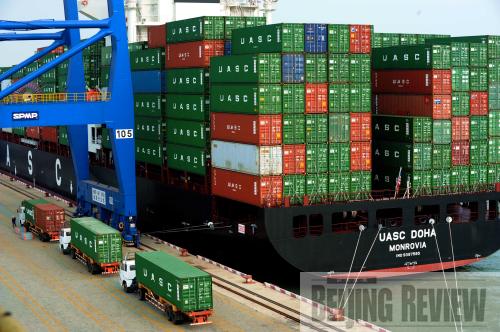|
 |
|
TRADE TURNAROUND: A great number of Chinese goods are exported all over the world through the bustling Xiamen Haicang Port (ZHANG GUOJUN) |
As massive government investments keep China's growth engine humming, the entrenched gloom appears to be giving way to a tide of optimism. This was a marked improvement, but not necessarily a guarantee of recovery, as worries arise that the growth momentum could dry up once policymakers phase out stimulus aid. Fan Gang, Director of the National Economic Research Institute under the China Reform Foundation, discusses these issues in an article recently published on the Economic Information Daily. Edited excerpts follow:
The Chinese economy is shaking off the enormous slack that has accumulated on the export front, making way for a sustainable trajectory out of the economic slump. High budget flexibility has put the government in a better position to buck up growth, and most importantly fresh incentives are sprouting up to bode well for a long-term prospective future.
The real estate market has seen remarkable improvement, but a peak in investments will not arrive until next year. The sales boom this year will provide property developers with more resources to devote to new projects in coming years. Many of them have already been rushing to scoop up land in major urban centers, signaling an investment upturn in the near future. This will provide an effective cushion against the downturn, and help shore up an array of upstream industries like steel and cement.
The manufacturing industry has also shown remarkable signs of improvement, lifting itself off a very low floor where it lay only a half year ago. The industry is less likely to see a substantial turnaround this year as enterprises clear up excess inventories and absorb overcapacity. A sharp uptrend should follow as the enterprises expand employment and restart investment projects that languished in the last year.
Demands for Chinese exports remain lackluster as Western consumers adopt a thrifty, conservative mindset in the wake of the deep recession. However, it is just a matter of time before the export woes fade as Chinese exporters leverage low costs and put more effort into branding. August exports grew 3.4 percent month-on-month, providing encouraging news that will hopefully be followed by a reversal in the prolonged downward streak.
Looking ahead, the world economy will take heart from the globally coordinated economic stimulation measures, though uncertainties will inevitably remain. The less-affected emerging economies will play a swift catch-up while Europe and Japan are reeling from a credit crunch and painful loss of jobs. The U.S. economy, in particular, may continue to sag in the shadow of the financial contagion.
The U.S. Government has pumped hundreds of billions of dollars into a bailout program almost as powerful as the 4-trillion-yuan ($586 billion) stimulus package of China. But a bulk of the money was used to fill deep holes in the balance sheets of beleaguered financial institutions. This almost certainly cannot create the same kind of demand as that experienced in China's spending spree on infrastructures.
In addition, China's precautious measures have also set up a firewall against the crisis. Long before the financial chaos broke out, Chinese policymakers had put a damper on the overheating economy and let air out of the real estate and stock market bubbles, paving the way for a much-needed soft landing of the economy. In another move, a sweeping reform a few years ago left Chinese banks less vulnerable to the sub-prime mortgage fallout.
All in all, we have confidence that the Chinese economy will grow at least 8 percent in the next two years, but holding up the long-term prospect will require more policy moves.
Road ahead
While the economic downturn is wearing off, its far-reaching implication for China's future may have just started to be felt.
First, the downturn has offered an obvious catalyst for China to shift its economy away from exports and rely more on domestic consumptions. The savings rate of Americans is on the rise, adding urgency to China's rebalancing task. It is now imperative for policymakers to make repairs to the social security net and increase the income of residents to spark consumer interest. Efforts are also needed to bridge the rural-urban income gap to propel the underdeveloped rural economy.
Second, as the financial sector loses shine, the real economy gains weight as a solid foundation for the global recovery. So if there is one lesson China should learn from the financial crisis, it is this: never overlook the manufacturing industry, the beating heart of the economic miracle. In terms of the financial sector, it is also necessary to take full account of hidden risks.
Third, a global trend of low-carbon economy is taking shape as the Unite States and Japan have made a push into clean industries and new energies. In the face of acute energy shortages and environmental damages, China has a reason to press ahead with low-carbon technological advancements and promote the green economy.
Fourth, emerging economies have contributed to more than 40 percent of the world's economic growth, and will continue to be major contributors. Closer monetary and trade coordination between these emerging economies is adding luster to their revitalization efforts. Whether many Chinese exporters could survive and prosper amid downturns may to an extent depend on how well they fare in the emerging markets.
Fifth, the financial crisis offered an opportunity for ambitious Chinese enterprises to become global players as they acquire financially distressed foreign assets. But taking a page from history books may be necessary in this endeavor, as the path to going global is hidden with pitfalls. As a result, the expansion-minded Chinese enterprises must keep a vigilant eye on potential risks, such as cross-cultural differences and management obstacles. | 